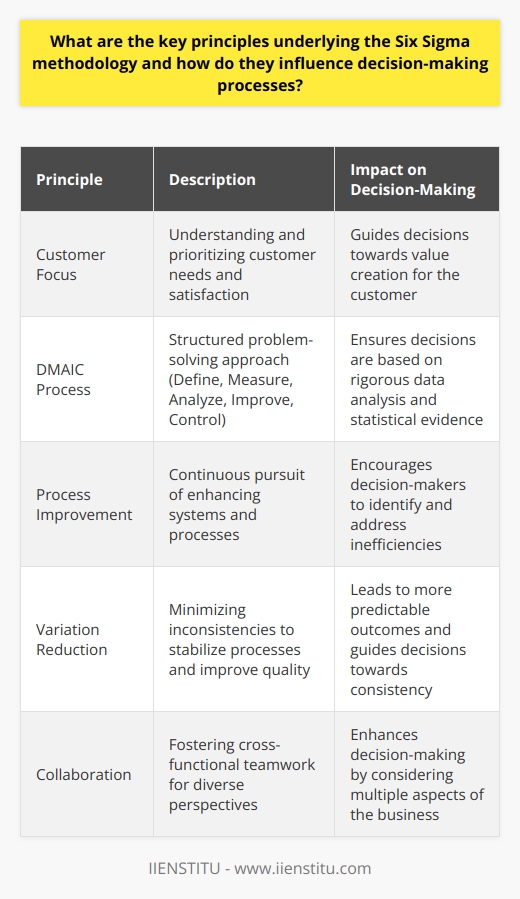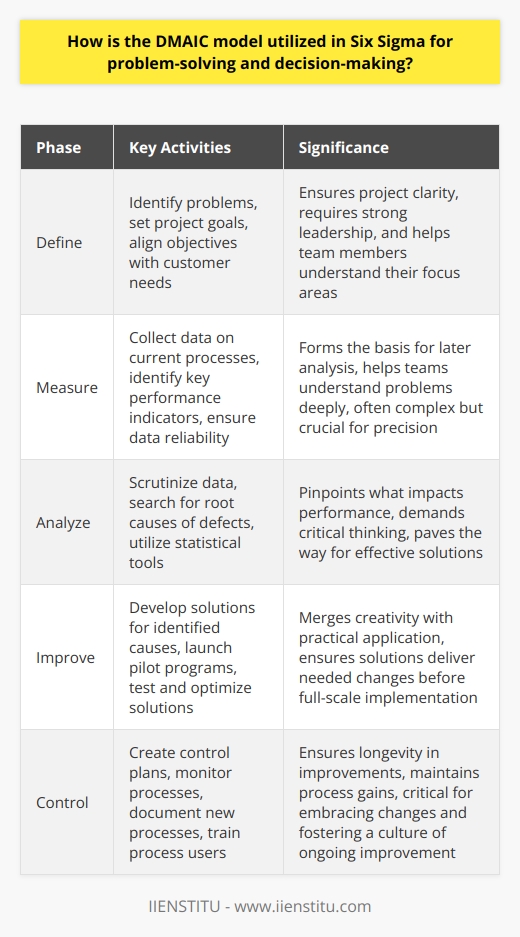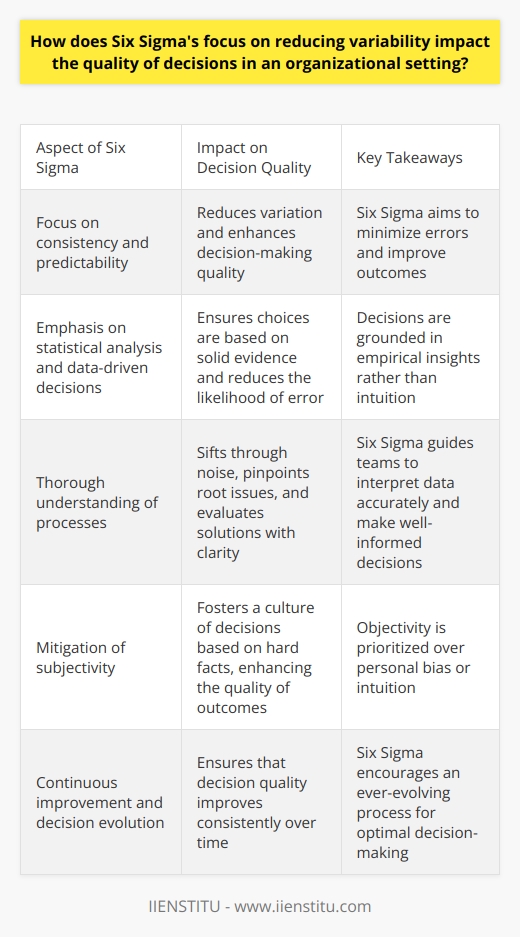
Within the realm of business management and quality control, Six Sigma stands as a preeminent methodology that has revolutionized the way organizations approach process improvement and efficiency. Rooted in statistical mathematics, Six Sigma's primary objective is to minimize variability in business processes, enabling companies to improve the predictability of their operations.
Since its inception in the latter half of the 20th century, Six Sigma has evolved into an invaluable framework for organizations aiming to maximize customer satisfaction, streamline production, and enhance their overall operational performance.
Definition of Six Sigma
At its core, Six Sigma is a disciplined, data-driven approach focused on eliminating defects in any process -- from manufacturing to transactional and from product to service. By employing Six Sigma techniques, businesses strive to reduce process variation, aiming for near perfection with a target of 3.4 defects per million opportunities (DPMO).
The 'sigma' in Six Sigma refers to the measure of standard deviation, which is a statistical term indicating the degree of variation in a set of processes or data points. Ideally, a Six Sigma process is one that produces outcomes within a narrow band of acceptability, six standard deviations from the mean on either side.
Brief Historical Background
Pioneered by engineer Bill Smith at Motorola in the 1980s, Six Sigma was initially conceptualized to improve manufacturing processes and reduce defects. It quickly gained prominence for its ability to significantly boost the quality of output and increase efficiency.
The methodology's success story spread through industries across the globe after major conglomerates such as General Electric implemented it under the guidance of their CEO, Jack Welch, who became a champion of Six Sigma in the 1990s.
Importance of Six Sigma in Today's Business World
In modern business contexts, Six Sigma has become synonymous with excellence and continuous improvement, cementing its importance as an essential element of organizational strategy. It is no longer confined to manufacturing but is applied across various sectors, including healthcare, finance, and IT services. Amidst increasing competition and the need for innovation, Six Sigma provides a structured approach to problem solving training and precision in operational tasks, ultimately driving businesses towards sustainable success.
Understanding the Basics of Six Sigma
The successful implementation of Six Sigma is contingent upon a solid understanding of its foundational principles and methodologies. It requires a shift in organizational culture to embrace data-driven analysis and decision-making processes.
Key Principles of Six Sigma
About the Customer Focus and Centricity: Six Sigma places immense focus on understanding and meeting customer needs, often characterized by the term "Voice of the Customer" (VoC). This principle considers customer feedback as a pivotal component for defining quality parameters. High-quality services or products are those that meet or exceed customer expectations, leading to customer loyalty and repeat business.
Importance of Data-Driven Approach: Decisions in a Six Sigma framework are informed by quantifiable data, eliminating guesswork and assumptions. This emphasis on facts and data underpins the rigor of the methodology, ensuring that process improvements are measurable, repeatable, and verifiable. By leaning on statistical methods, organizations can objectively diagnose and solve problems.
Continuous Improvement Cycle: The philosophy of continuous improvement in Six Sigma is encapsulated by the concept of "Kaizen," which translates to gradual and unending improvement. This concept is foundational to creating an organizational culture that is never complacent and always striving for better processes, products, and customer satisfaction.
Six Sigma Methodologies: Within Six Sigma, there are several tactical methodologies designed to guide practitioners through the improvement process.
DMAIC (Define, Measure, Analyze, Improve, Control): DMAIC is a core Six Sigma methodology used to refine existing processes. Each phase - Define, Measure, Analyze, Improve, Control - builds upon the previous one, ensuring that improvements are based on data and monitored over time.
DMADV (Define, Measure, Analyze, Design, Verify): The DMADV framework, on the other hand, is applied when creating new products or processes. It closely resembles DMAIC but focuses on designing and verifying before implementation to avoid problems from the onset.
DFSS (Design For Six Sigma): Integrating the principles of Six Sigma from the very beginning of product or process design is the realm of DFSS. This approach aims to preemptively address quality control and efficiency, rather than merely correcting problems post-development.
Roles and Responsibilities in Six Sigma
In Six Sigma, roles are clearly defined and tiered, creating a structured chain of responsibility within an organization. Personnel trained in Six Sigma are designated with belt colors reminiscent of martial arts, indicating their level of mastery and role within the Quality Management hierarchy.
The Role of Green Belts: Green Belts hold foundational knowledge of Six Sigma methodologies and serve as the workhorses of process improvement projects. They analyze and solve quality problems and are involved in quality-improvement projects.
The Role of Black Belts: Black Belts are professionals who have undergone more intensive training and have a deeper understanding of Six Sigma philosophies and principles. They lead projects, coach Green Belts, and are responsible for significant process improvements.
The Role of Master Black Belts: As the name suggests, Master Black Belts are the highest level of technical and organizational proficiency. They provide expert guidance to Black and Green Belts, and they focus on the strategic implementation of Six Sigma across the organization.
The Role of Champions and Executives: Champions and executives are the leadership figures responsible for the deployment of Six Sigma within an organization. They work at the highest levels to set visions for projects and ensure that resources are available to achieve desired outcomes.
Benefits and Challenges of Implementing Six Sigma
The narrative of Six Sigma is replete with successes that underscore its immense value to organizations. However, like any other business strategy, it comes with its own set of challenges in the implementation process.
Significant Improvements in Quality: Implementing Six Sigma methodologies has consistently resulted in remarkable improvements in the quality of products and services. By focusing on defect reduction and process standardization, companies achieve high reliability in their operational processes.
Enhanced Customer Satisfaction: By aligning the objective of quality improvement with customer expectations, Six Sigma propels organizations towards achieving enhanced customer satisfaction. Satisfied customers are likely to become repeat clients and advocates for the brand.
Reduction in Costs and Waste: One of the tangible benefits of implementing Six Sigma is the noticeable reduction in operating costs. This occurs as a result of improved efficiency, reduction of waste, and eradication of non-value-added activities.
Challenges in the Implementation Process: However, organizations often encounter resistance to change, a scarcity of resources, or a lack of commitment from top management during the implementation of Six Sigma. Additionally, without a thorough understanding of the methodologies and tools involved, the application of Six Sigma can be misdirected, leading to suboptimal results.
Real-world Examples of Six Sigma
To clarify the impact of Six Sigma, exploring real-world applications across various industries provides a lens into its transformative capabilities and versatility.
Six Sigma in Healthcare
In healthcare, Six Sigma has been used to improve patient care by streamlining processes such as appointment scheduling, medication administration, and reducing medical errors, leading to better patient outcomes and hospital efficiency.
Six Sigma in Manufacturing
Manufacturing is where Six Sigma has one of its most natural fits. It's been utilized to minimize product defects, shorten cycle times, and manage supply chain logistics, all of which contribute to enhanced productivity and customer satisfaction.
Six Sigma in Service Industries
Services industries, such as banking and IT, benefit from the customer-centric approach of Six Sigma to improve service delivery, response times, and client satisfaction, often leading to an edge in competitive markets.
Future of Six Sigma in the Era of AI and Big Data
As the technological landscape evolves, the principles of Six Sigma are being integrated with emerging technologies like Artificial Intelligence (AI) and Big Data, paving the way for even more refined processes and innovations.
Integration of Six Sigma with New Technologies
The merging of Six Sigma with AI and Big Data analytics heralds a new era of advanced process optimization. These technologies provide unprecedented insights and predictive capabilities that enhance the Six Sigma toolkit.
Updated Models and Frameworks
As a result, Six Sigma models and frameworks are being updated to include these technological advancements, creating hybrid approaches that amplify the value Six Sigma offers to contemporary organizations.
Future Skills and Competencies for Six Sigma Professionals
For professionals, this evolution sparks a need for new skills and competencies that encompass online certificate programs in data science, machine learning, and process automation, making today's Six Sigma practitioners tomorrow's leaders in process innovation.
Conclusion
As organizations perpetually strive for excellence, Six Sigma stands as a proven approach that offers a structured framework for ongoing quality improvement and cost reduction.
Recap of Key Concepts and Ideas
Reflecting upon Six Sigma principles, methodologies, and real-world applications underpins why this disciplined, methodical approach to problem-solving and continuous improvement is critical to the success of modern businesses.
Encouraging the Adoption of Six Sigma
It is essential to encourage the wider adoption of Six Sigma across industries, as the benefits it brings go beyond just financial metrics, impacting everything from employee engagement to customer loyalty and brand reputation.
Final Thoughts and Impressions
In closing, Six Sigma is not only a set of tools or an isolated business strategy; it is a philosophy of operational excellence that, when integrated with progressive technologies and shaped by insightful leadership, promises to continue guiding organizations to exceptional levels of performance.
Frequently Asked Questions
What are the key principles underlying the Six Sigma methodology and how do they influence decision-making processes?
Understanding Six Sigma Principles
Six Sigma stands as an acclaimed methodology in quality management. Its primary focus rests on process improvement through identifying and removing defects. This methodology derives from statistical thinking. Statistics govern Six Sigma's core. Its principles weave through every aspect, influencing decision-making significantly.
The Foundation of Six Sigma
First, we consider customer focus. Six Sigma revolves around understanding customer needs. This customer-centric approach prioritizes satisfaction. It guides decisions towards value creation for the customer.
Define, Measure, Analyze, Improve, and Control (DMAIC) serves as Six Sigma's backbone. This structured process offers a roadmap for problem-solving. Each phase demands meticulous data analysis. Decision-making involves rigor. Every step weighs on statistical evidence.
Another key principle stands as process improvement. Six Sigma aims at enhancing systems and processes. It encourages a continual pursuit of excellence. Decision-makers must seek out inefficiency relentlessly.
Process capability enters the fray. It is essential. This principle dictates the ability of a process to produce defect-free outcomes. Understand this capability informs critical choices. It allows for better quality prediction and control.
Variation is an enemy in the Six Sigma framework. Variation equates to inconsistency. Reducing variation is thus essential. Doing so stabilizes processes. Stable processes yield predictable, high-quality results. Decision-making follows this consistency search. Less variation leads to more predictability.
Proactive management enters the discussion. Reactive approaches fall short. Six Sigma fosters anticipation. Leaders must foresee potential setbacks. Prediction guides decision-making towards proactive solutions.
A workforce armed with knowledge represents a core tenet. Six Sigma necessitates thorough training. Equipped employees make informed decisions. They can navigate complexity with greater ease.
Finally, we consider collaboration. Silos hinder process improvement. Cross-functional teamwork enhances understanding. Decisions benefit from diverse perspectives.
Impact on Decision-Making
Six Sigma weaves these principles into every decision. Leaders with Six Sigma training make choices based on data. They understand the importance of meeting customer requirements. Consequently, customer satisfaction influences decisions profoundly.
The DMAIC cycle dictates a data-driven approach. Decisions do not stem from intuition alone. Each phase of DMAIC involves careful analysis. This means that choices are often supported by robust evidence. The measure phase quantifies problems. Analyze delves into causation. Improve generates solutions. Control ensures sustainability of improvements.
Process improvement underlies many decisions within the Six Sigma framework. Leaders aim for streamlined processes. They make choices that promote efficiency. They choose what to refine and when by focusing on areas with the most significant potential for impact.
Understanding process capability allows for informed decisions about quality. In settings where high variability exists, efforts center on standardization. Variation reduction guides the choices towards stability. This stability translates to reliable quality.
Proactive management changes the decision-making landscape. Leaders anticipate problems. They develop strategies before issues materialize. Thus, decision-making shifts. It becomes preventative rather than remedial.
Knowledge empowers the workforce. Trained employees participate in decision-making. They understand Six Sigma principles. They apply these in their areas of expertise. Their input makes decisions more well-rounded. It reflects cumulative expertise.
Collaboration further informs decisions. When cross-functional teams unite, they produce more expansive solutions. These solutions consider multiple aspects of the business. Thus, decisions embody holistic business improvement.
Summation
Six Sigma principles exert a strong influence on decision-making. They shift the focus to data, customer needs, process efficiency, and quality control. Decisions in a Six Sigma-guided organization rest on statistical evidence. They prioritize what adds value for the customer, reduces waste in processes, and ensures optimal product quality. The proactive, knowledgeable, and collaborative culture Six Sigma fosters allows for well-informed, forward-thinking, and impactful decisions.

How is the DMAIC model utilized in Six Sigma for problem-solving and decision-making?
Understanding DMAIC in Six Sigma
Six Sigma stands strong on its problem-solving framework. Known as DMAIC, it provides a structured, five-phase method. Each phase has a unique role. Together, they ensure thorough examination and improvement.
Define the Problem
Initiating the DMAIC model, the Define phase emerges. Here, problems receive identification. It sets project goals. Teams come to know what they must achieve. Objectives align with customer needs. Businesses realize this phase’s importance for project clarity. It requires strong leadership. Team members must understand their focus areas.
Measure Current Processes
The Measure phase follows. Measurement is vital. Teams collect data on current processes. They seek key performance indicators. Reliability in data is paramount. This stage is often complex. Yet, teams rely on precision to understand problems deeply. It forms the basis for later analysis.
Analyze to Identify Causes
Analyze forms the third phase. Here, teams scrutinize data. They search for root causes of defects. Statistical tools become essential. The aim is clear - pinpoint what impacts performance. This demands critical thinking. Teams often encounter multiple potential causes. Rigorous analysis paves the way for effective solutions.
Improve Process Performance
Improvement takes the spotlight next. In the Improve phase, teams innovate. They develop solutions for the identified causes. Pilot programs often launch. Testing the solutions is crucial. They must deliver the needed changes. Creativity merges with practical application. Solutions are optimized before full-scale implementation.
Control to Sustain Gains
Lastly, we have Control. It ensures longevity in improvements. Teams create control plans. They aim to maintain process gains. Monitoring becomes routine. Without this phase, improvements may not last. It involves documenting the new process. Also, training for process users is critical. They must embrace the changes.
DMAIC serves as a cycle. It encourages continuous enhancements. Organizations must commit. They must recognize each phase's worth. Only then can they achieve peak performance. Through DMAIC, Six Sigma becomes a robust tool for business excellence. It leads to informed decisions. It translates into high-quality products and service delivery. Teams find it instrumental in fostering a culture of ongoing improvement.

How does Six Sigma's focus on reducing variability impact the quality of decisions in an organizational setting?
Six Sigma's Influence on Decision Quality
Six Sigma stands as a model for excellence. It focuses on consistency and predictability. This approach aims to diminish variation. Such a focus heightens decision-making quality in organizations.
The Core of Six Sigma
At its core, Six Sigma embraces statistical analysis. It prioritizes data-driven decisions. This ensures that choices rest on solid evidence. The consequence is a reduced likelihood of error.
Impact on Decision-Making Processes
Six Sigma demands a thorough understanding of processes. It envisions decisions that align with empirical insights. Thus, it affects decision quality by:
- Sifting through noise
- Pinpointing the root of issues
- Evaluating solutions with clarity
Six Sigma's Role in Data Interpretation
Six Sigma guides teams to interpret data accurately. It teaches rigorous analysis techniques. Decisions arise from well-understood facts. It prevents poor judgment based on ambiguous data.
Mitigation of Subjectivity
Subjectivity often skews decisions. Six Sigma introduces objectivity. It fosters a culture of decisions based on hard facts. This greatly enhances the quality of outcomes.
Enhancing Predictability in Operations
Variability threatens operational predictability. Six Sigma combats this by standardizing processes. It aligns expectations with reality. Thus, it supports more reliable decisions.
Impact on Risk Management
Every decision carries risk. Six Sigma equips teams to assess and mitigate risks more effectively. It advances a systematic approach to risk. This approach improves not only decision quality but also the confidence behind each decision.
Challenges in Implementation
Effective Six Sigma application is not without challenges. Proper training is essential. Organizations must overcome resistance to change. Only then can the framework truly enhance decision-making quality.
Continuous Improvement and Decision Evolution
Six Sigma emphasizes continuous improvement. Decisions benefit from an ever-evolving process. This ensures that decision quality improves consistently over time.
In conclusion, Six Sigma's insistence on reducing variability translates into more informed, consistent, and reliable decision-making within organizations. It shifts the focus from intuition to a systematic, data-oriented approach. The result is a significant enhancement in the overall quality of organizational decisions.


